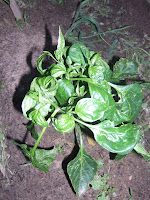Trees Going Dormant Due to Extreme Drought

Homeowners and gardeners across the state are worried about their trees’ shedding leaves weeks before normal.
Dr. Ken Tilt, a horticulturist with the Alabama Cooperative Extension System, says the ongoing drought is taking its toll on trees.
“One survival mechanism for trees is early leaf drop,” says Tilt. “If there is no leaf exposure, demand for water decreases. They are going dormant to survive.”
He explains that leaf drop is just one way trees conserve water in drought. Sometimes leaves roll up to reduce the exposed area to wind, sun and heat, which reduces water loss. The primary mechanism is the closing of pores in the leaves that allow water movement into the air.
Essentially the plant shuts down—halting photosynthesis and growth. Leaves and stems may wilt or droop. Leaf edges may burn and turn brown from the heat and dry conditions.”
Tilt says the lack of photosynthesis may have another effect.
“People should also not be surprised if we have early fall color this year. When photosynthesis stops, the green will fade exposing the other pigments in the leaves.”

Shane Harris, an Extension regional horticulture agent, says leaf drop is happening around central Alabama.
“I have had a number of calls from people who are worried about their trees,” he says. “I’ve seen yellow poplar and several kinds of oak, including water, red and post species dropping leaves.”
Tilt and Harris agree that early leaf drop does not necessarily mean the tree is dead or dying. They also agree that it is an indication of extreme stress that will affect trees after normal weather patterns resume.
“Some plants tolerate this stress better than others,” says Tilt. “Some will leaf out in spring but others may die.”
He says that site conditions and moisture content are two factors in how a specific tree responds to drought.
Harris says that a favorite tree of Alabama gardeners is very susceptible to drought.
“Dogwoods have shallow roots and suffer the most from heat and drought,” says Harris. “Dogwood leaves may turn brown along the edges, turn completely brown, or the tree may die outright.”
 “
“
Drought has long-lasting effects on trees.
“A tree might not die this year but stress is cumulative,“ says Tilt. “Root disturbance, storm damage, soil compaction or another drought are all types of stress. In most cases where the tree dies, it’s the result of a number of years of problems and stresses and not just one particular thing. “
Tilt emphasizes that stress makes trees more susceptible to disease and insects.
“A severe drought might not kill a mature pine, but it weakens the tree tremendously,” says Tilt. “That makes the tree more vulnerable to pine beetles, which can kill it. While the beetles are the agent of the tree’s death, it was drought-related stress that opened the door for the beetles.”
Tilt and Harris say the obvious answer to drought stressed trees is irrigation.
“But irrigation can be a challenge because restrictions and bans on landscape irrigation are often in place during droughts,” says Tilt.
He suggests homeowners placing mulch over trees’ root zones and to use systems such as rain barrels to capture and recycle any rain that falls.
Joe













 “
“





































